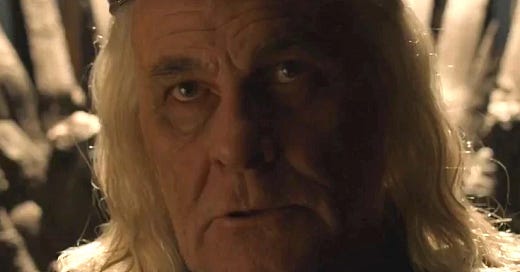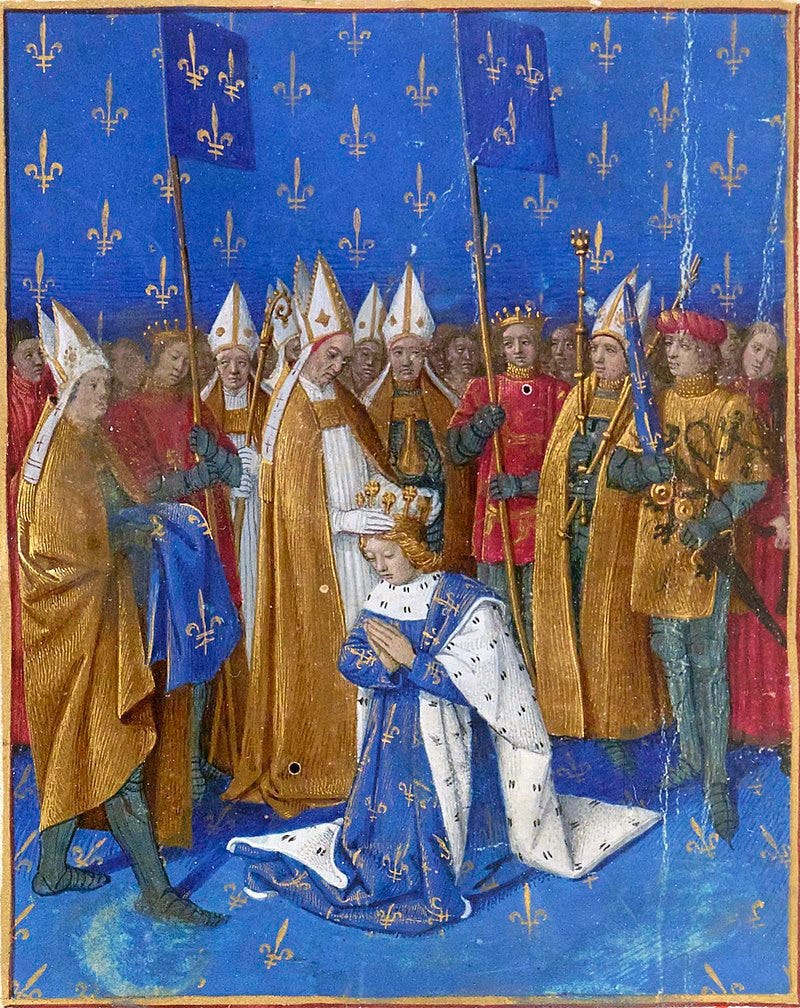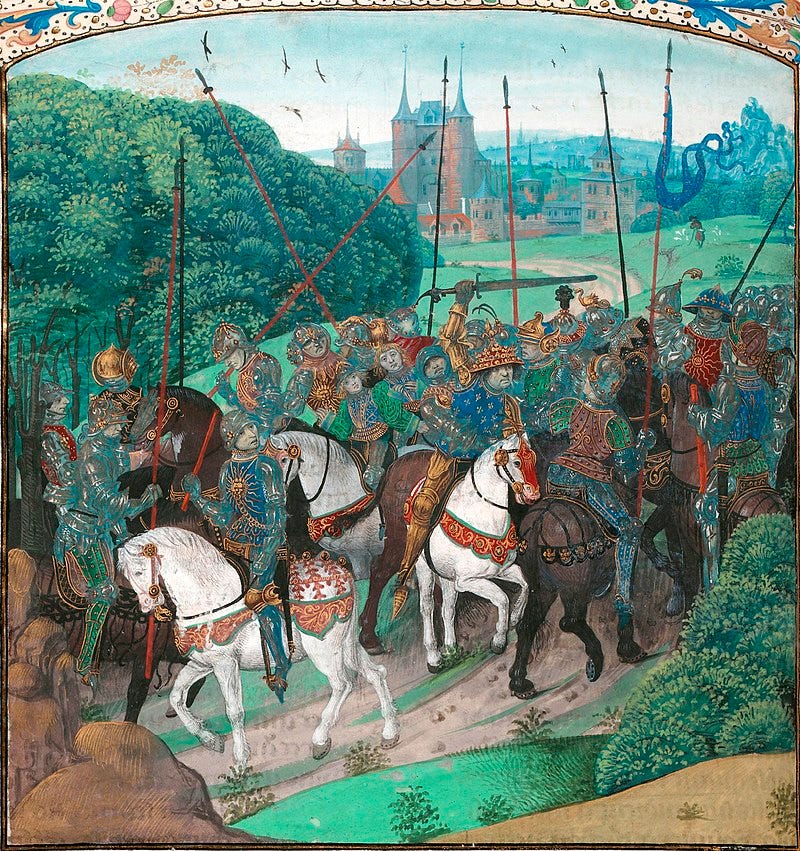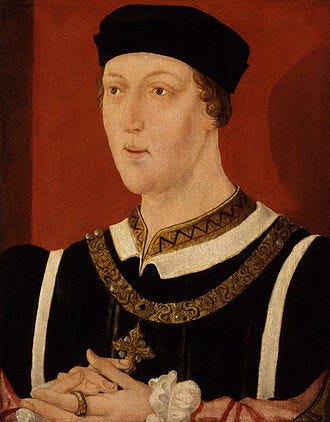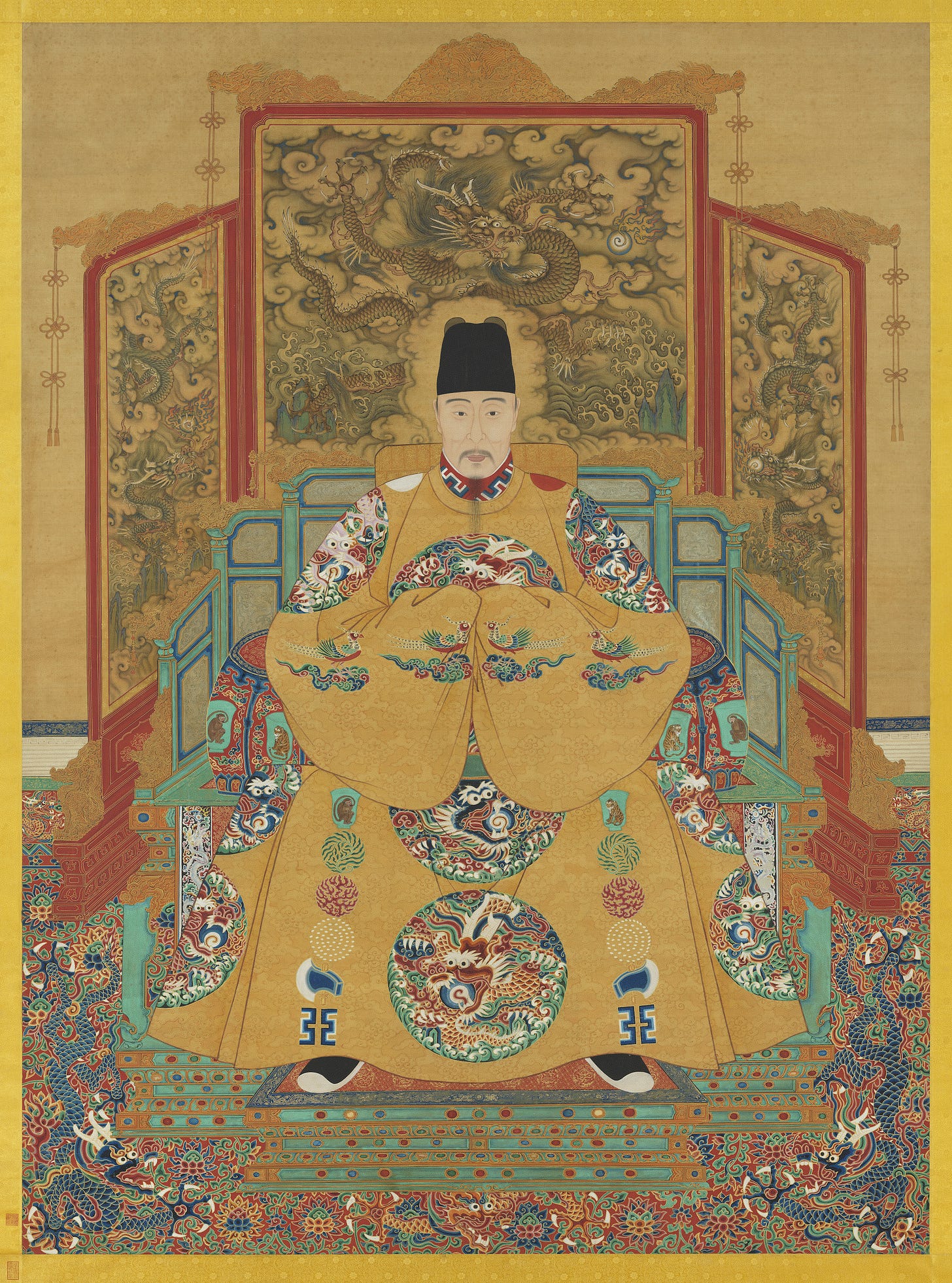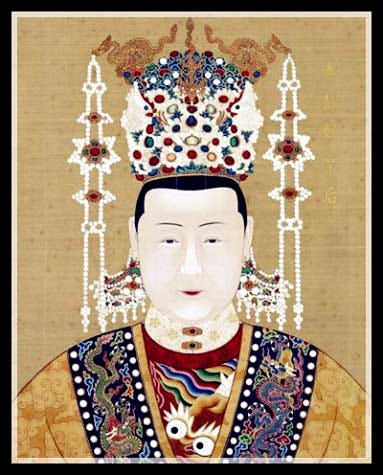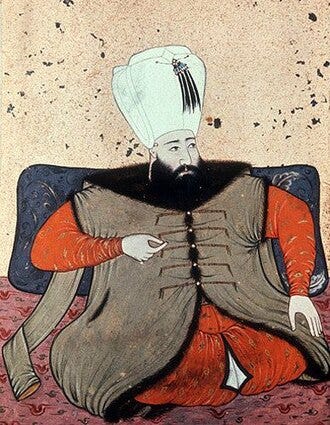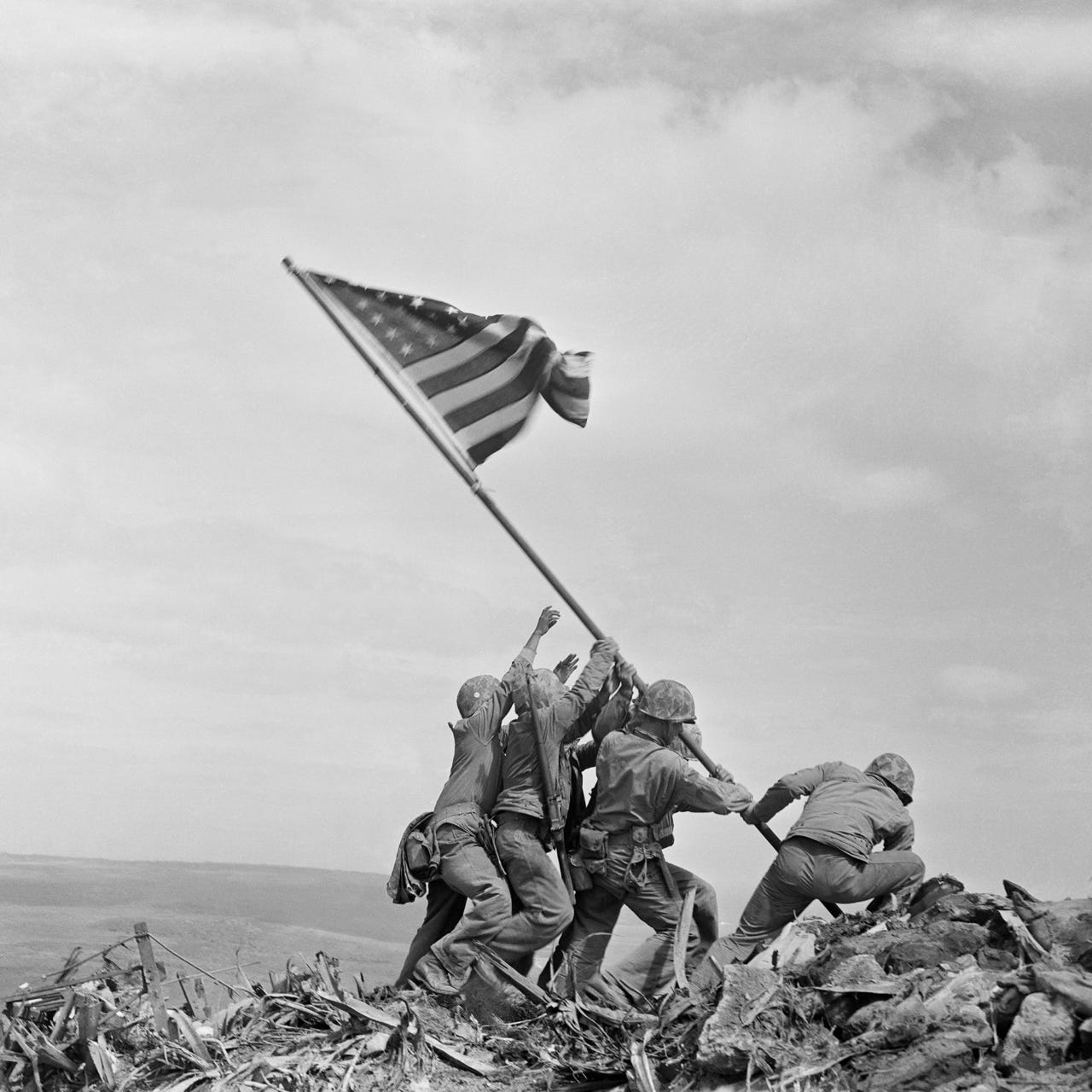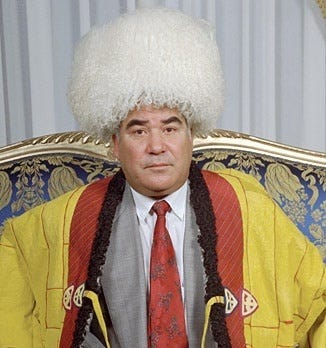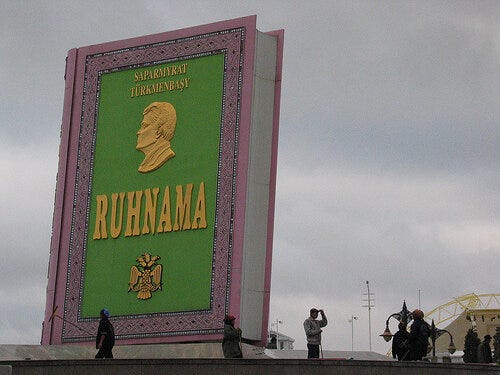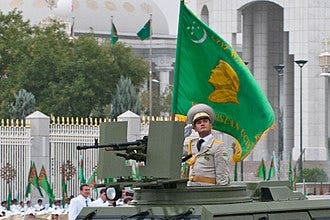Interesting People Throughout History Part III
Everything you wanted to know about some of the strangest rulers in the history of the world.
Last time you caught me slinking around your inbox, I was dropping my Third Annual “What Memorial Day Means to Me” post. Click below if you missed it.
Today I’m going back to the history well, but this time I’ll be looking at some of the strangest rulers in the history of the world. I’m not going to be talking about any Romans in this post, they have been done to death (pun intended). I’m going to bring you some rulers you might not have heard of, at least that’s what I hope. So let’s jump right in.
Charles VI - France
Reign: 1380-1422
Charles VI of France is remembered for two things: his crushing defeat by the English at Agincourt, and the fact that he was really quite mad.
in 1392 Pierre de Craon attempted to assassinate Olivier the Fifth Duke of Clisson, the Constable of France, and a close friend and advisor to King Charles. Although Clisson survived, the king was gripped by an "insatiable fury" to punish the would-be assassin. de Craon had taken refuge in Brittany, but John the Fifth Duke of Brittany, was unwilling to hand him over, so Charles prepared a military expedition. Contemporaries reported that Charles appeared to be in a "fever" to begin the campaign but seemed confused in his speech and actions. He set off with an army on July 1, 1392. The progress of the army was slow, driving Charles into a frenzy of impatience. In August, as the king and his escort were traveling through the forest near Le Mans1, a barefoot leper, dressed in rags rushed up to the king's horse and grabbed his bridle. "Ride no further, noble King!" he yelled: "Turn back! You are betrayed!" The king's escorts beat the man back but did not arrest him, and he followed the procession for half an hour, repeating his cries. After the company emerged from the forest at noon, a page who was drowsy from the sun dropped the king's lance, which clanged loudly against a steel helmet carried by another page. Charles shuddered, drew his sword and yelled, "Forward against the traitors! They wish to deliver me to the enemy!" The king spurred his mount, and attacked his own knights, including his own brother, killing four, before one of his chamberlains and a group of soldiers were able to grab him from his mount and lay him on the ground.
He lay still and did not react, and fell into a coma. He was taken to the castle of Creil in Le Mans, where it was hoped that good air and pleasant surroundings might bring him to his senses. Few believed he would recover; his uncles, the dukes of Burgundy and Berry, took advantage of the king's illness and quickly seized power, re-established themselves as regents and dissolved the King’s Council. In Le Mans, Guillaume de Harsigny, a venerated and well-educated 92-year-old physician, was summoned to treat him. After four days Charles regained consciousness and his fever subsided, Harsigny brought Charles back to Paris, moving slowly from castle to castle with periods of rest in between. Late in September, Charles was well enough to make a pilgrimage of thanks to Notre-Dame de Liesse near Laon, after which he returned again to Paris and resumed his reign.
On January 29, 1393, a masked ball, which later became known as the Bal des Ardents ("Ball of the Burning Men"), was organized at the Hotel Saint-Pol, the royal residence, by Charles’ wife and Queen of France, Isabeau of Bavaria, to celebrate the wedding of one of her ladies-in-waiting. Charles decided that as part of the celebrations the he and four other lords dressed up as wild men would perform a dance while dressed "in costumes of linen cloth sewn onto their bodies and soaked in resinous wax or pitch to hold a covering of frazzled hemp, so that they appeared shaggy and hairy from head to foot." The king also decided that torch-bearers were to stand at the side of the room for ambiance. Apparently no one thought that having people dressed in flammable costumes near torches was a bad idea. After a while the inevitable happened, the king's younger brother, Louis, First Duke of Orleans, who had arrived late, approached the wild men with a lighted torch to discover the identity of the dancers, and accidentally set one of them on fire. There was panic as the flames spread. The Duchess of Berry, the kings aunt, threw the train of her gown over the king to protect him. Several knights who tried to put out the flames were severely burned. All the dancers, save the king and one other perished: Charles de Poitiers, son of the Count of Valentinois, Huguet de Guisay, Yvain de Foix, and the Count of Joigny. Another dancer, Jean, son of the Lord of Nantouillet, saved himself by jumping into a dishwasher’s tub.
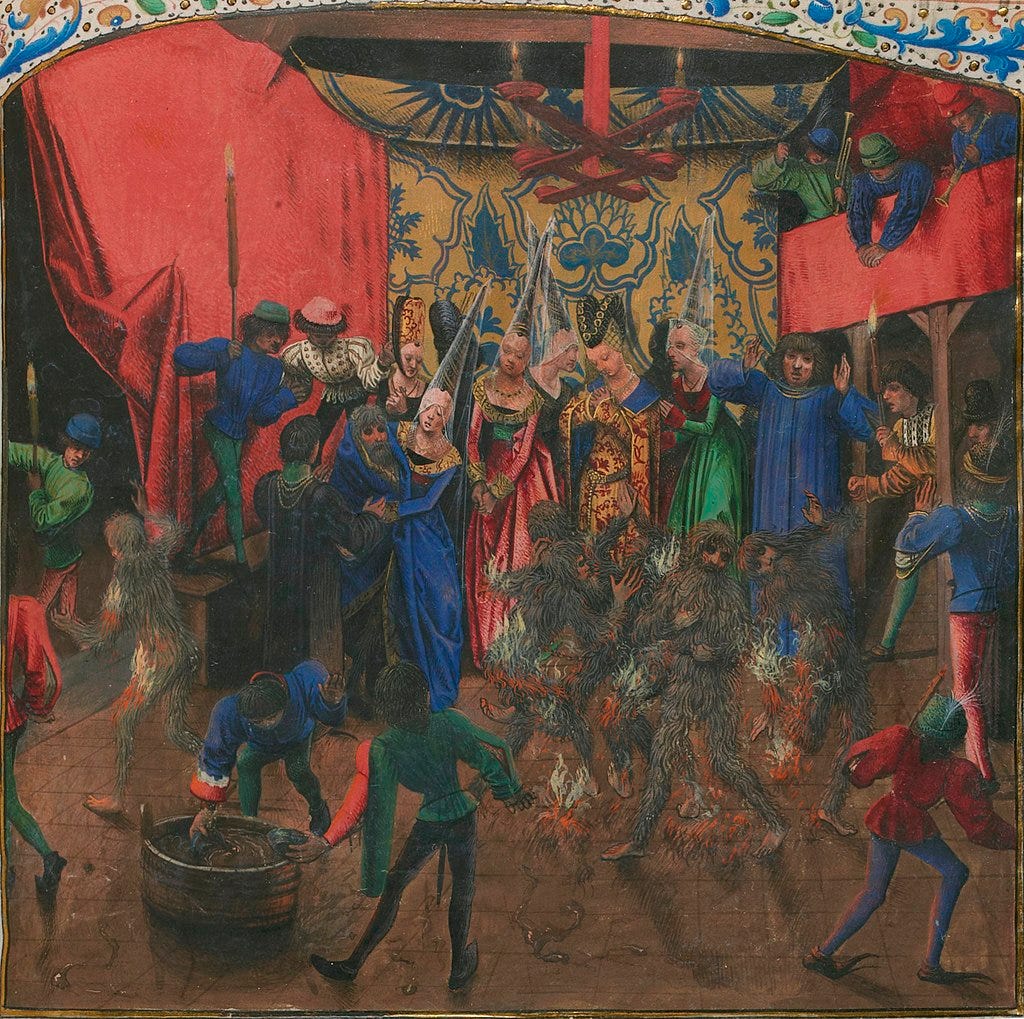
Later in 1393, he forgot his name and the fact that he was king. He recognized his servants and officers, but could not remember his wife or children. When his wife came to visit in an attempt to help, he ordered his servants to look after her but also get rid of her. Then for a year he began claiming he was Saint George. Around the same time, he took to running wildly around the corridors of Hotel Saint-Pol. It became such a problem that to keep him inside and safe, that entrances had to be walled up. In 1405, he refused to bathe or wear clean clothes for five months. We also know that at some point Charles began to believe he was made of glass. He became terrified of breaking and wouldn’t let anyone touch him. He would sit still for hours and even went as far as having iron rods sewn into his clothing to protect him. After this last bout of madness, records of his mental illness become scarcer. It is likely that this is not because he recovered but because his bouts of insanity became so numerous that people gave up keeping track of them. The mental illness that seemed to plague him may have been passed on for several generations through his mother, Joanna of Bourbon. It is hard to diagnose Charles VI after the fact and with a spotty and biased account but doctors believe he might have suffered from familial schizophrenia syndrome, and bipolar disorder. Although he was still called Charles the Beloved, by his subjects, he also became known also as Charles the Mad.
Charles VI's reign was marked by the continuing conflict with the English, known as the Hundred Years’ War. An early attempt at peace occurred in 1396 when his daughter, the almost seven-year-old Isabella of Valois, married the 29-year-old Richard II of England. By 1415, however, the feud between the French royal family and the House of Burgundy led to chaos and anarchy throughout France, a situation that Henry V of England was eager to take advantage of. Henry led an invasion that culminated in the defeat of the French army at the Battle of Agincourt in October. On May 21, 1420, Henry V and Charles VI signed the Treaty of Troyes, which named Henry as Charles's successor and stipulated that Henry's heirs would succeed him on the throne of France. It disinherited the Dauphin Charles, then only aged 17. Charles VI died on October 21, 1422 in Paris, at the Hôtel Saint-Pol. Henry V died just a few weeks before Charles, in August 1422, leaving an infant son, who became King Henry VI of England. Therefore, according to the Treaty of Troyes, with the death of Charles VI, Henry VI became King of France. His coronation was held at Notre Dame cathedral in Paris on December 26,1431. The son disinherited by Charles VI, the Dauphin Charles, continued the fight to regain his kingdom. In 1429, Joan of Arc led his forces to victory against the English and took him to be crowned in Reims cathedral as King Charles VII on July 17, 1429. He became known as "Charles the Victorious" and was able to restore the French line to the throne of France by defeating the English in 1450. We will see how this affected Henry in the next story.
King Henry VI - England
Reign 1422-1461
Henry VI, was born December 9, 1421, and was crowned King of England on September 1, 1422,. Yes, before his first birthday! As we have seen, on October 21, 1422, less than two months after he succeeded the English throne, and still before he turned one, Henry’s grandfather, King Charles VI, died and Henry was crowned King of France, according to the Treaty of Troyes. Henry ruled during the turbulent time of the Hundred Years’ War and his reign was never an easy one, especially for a person described as shy, passive, and averse to warfare and violence.
Unlike so many other English kings, Henry VI never took a mistress. Maybe Henry actually loved his wife, Margaret of Anjou, but others have suggested a slightly stranger reason: It was long rumored that Henry had a hopeless phobia of naked bodies. According to one chronicler, Henry literally ran away in fear after a lord brought a gang of bare-chested ladies to a Christmas celebration as a dirty joke. It also took nearly a decade of marriage for Margaret to get pregnant, and most people place the blame for that on Henry's, difficulties in the bedroom. The king apparently had absolutely no idea what he was doing, and people noticed. Reportedly, some of the couple's most "trusted" attendants eventually joined them in the bedroom to ensure that they did the deed properly.
The military successes of Henry’s father, Henry V, meant that England held vast territories in France. These were, however, gradually lost over the course of Henry VI’s reign. In 1453, when he was informed of England’s defeat during the Battle of Castillon, which left Calais as England’s last remaining territory in France, Henry VI suffered a complete mental breakdown. It left him in a virtually catatonic state for more than a year. He sat in his room day in, day out, slumped like a rag doll in his chair, even failing to respond to the birth of his son and heir, Edward. No one knew if or when he may recover.
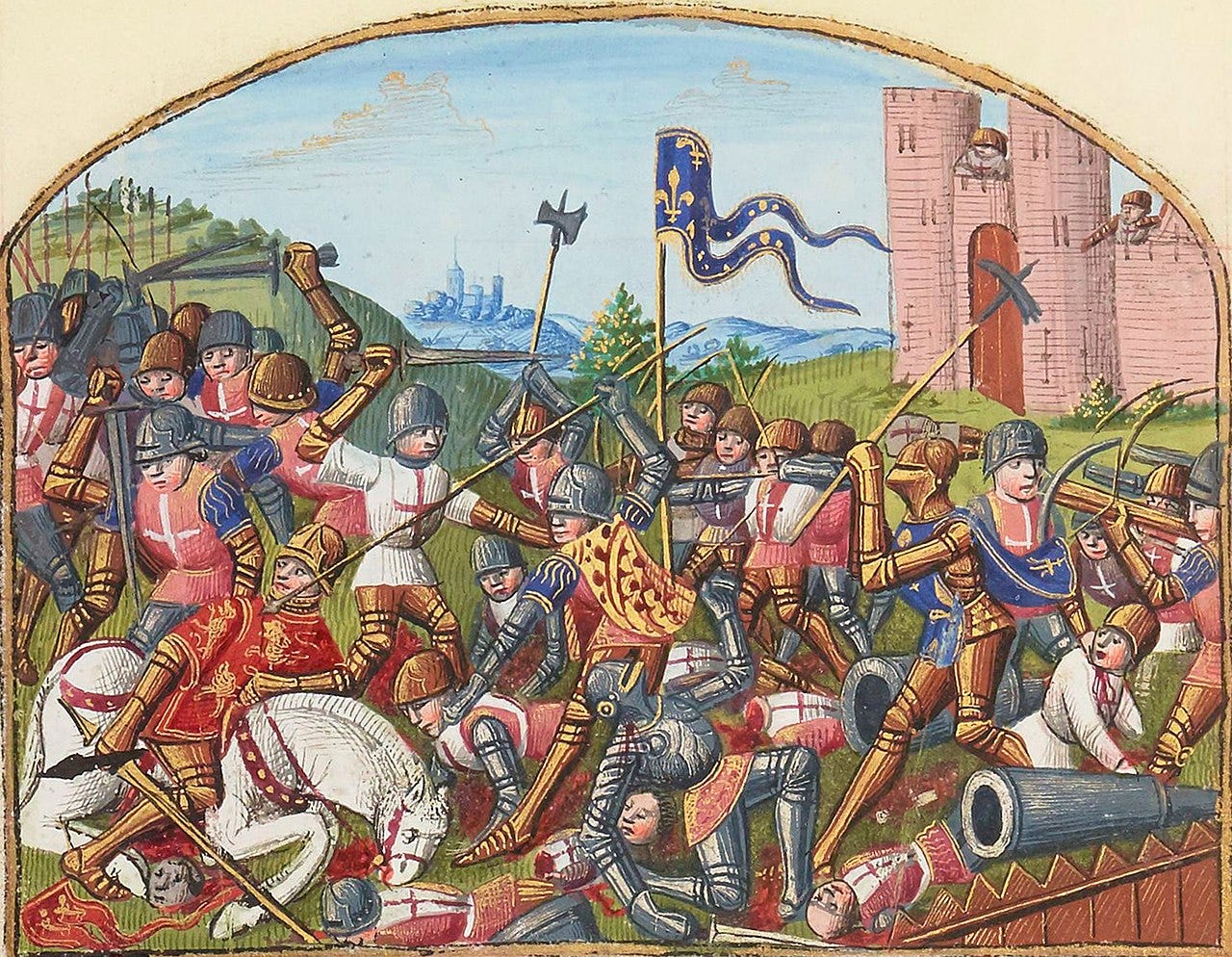
In his unpublished biography of the king, K.R.J. Tattersall writes:
“The King fell into an inertia; a torpor from which he could not be roused. At first his household tried to keep the matter as quiet as possible in the hope that the fit, or whatever it was, would soon pass and Henry would return to his normal self. But it quickly became evident that it would not pass so easily and so could not be kept a secret for any length of time. For the time being he remained at the hunting lodge of Clarendon, since he was clearly in no condition to travel. At Westminster the Council carried on government in the King's name as if nothing had happened, but they were not going to be able so to continue if the King's state did not soon improve.”
Around Christmas Day 1454, King Henry regained his senses. The Earls of Warwick and Salisbury, disaffected nobles who had grown in power during Henry's reign, took matters into their own hands. They backed the claims of the rival House of York, first for control of government, and then to the throne itself, pointing to York's better descent from Edward III. These rival claims and the weakness of Henry VI would eventually cause the Wars of the Roses. So devoted was Henry to the idea of peace, he once attempted to instigate a “Love Day” to help reconcile the warring factions of the Wars of the Roses. The plan was a parade on March 24, 1458, in which the leading Lancastrians would hold hands with the leading Yorkists as they walked through the streets of London. Needless to say, the plan did nothing to quell the hostility between the two sides.
I’m not going to go into the whole Wars of the Roses thing or this will be a thirty part story. Suffice it to say that eventually Henry VI lost and was imprisoned in the Tower of London and was “found dead” on May 21, 1471.
Emperor Jiajing – China
Reign 1521-1567
In 1521, during China's Ming Dynasty, the Zhengde Emperor unexpectedly died at the age of 29, shortly after he drunkenly fell off a boat and contracted something fatal from the Yellow River. He had no sons, no heir, and the throne passed to his first cousin Zhu Houcong who took the name Jiajing Emperor. However, because of his unusual succession, there was a conflict called "The Great Rites Controversy". Jiajing Emperor resolved the controversy with a few hundred banishings, floggings, and executions. He was never supposed to succeed to the throne and wasn’t really all that keen on the job. He made it a point to shirk his duties, leaving decisions to his Grand Secretary Yan Song. Song became so corrupt that he openly sold government positions for cash. Meanwhile, the Jiajing Emperor went to live in isolation, away from the imperial residence, the Forbidden City. He only took audiences with a few eunuchs, Taoist priests and Yan Song. Even though Jiajing means “admirable tranquility” the 12th Emperor of the Ming Dynasty was far from tranquil. Jiajing dabbled in Taoism and became obsessed with obtaining the legendary elixir of immortality. The emperor believed that collecting the menstrual blood of female virgins and using it to make a substance called ‘red lead’, would give him powers that would enable him to live forever. Numerous girls aged 13-14 were kept for the production of this vile concoction, and were fed only mulberry leaves and rainwater, as the Emperor believed this would keep his substance pure. Any of the girls who became sick were beaten or sometimes thrown out of the palace. As part of the girls' daily life, they woke early and collected dew from the garden's banana trees, taking it to the Jiajing Emperor to drink, another of his methods for longevity. Many of the girls fell ill from the cold and were punished for becoming sick. His concubines were also violently beaten into submission so they would passively cater to his every sexual whim.
However, in 1542, after twenty-one years of his reign and hundreds of girls treated in this way, including over 200 girls beaten to death. 16 of his ill-treated concubines banded together to plot the murder of this sadistic ruler. One evening, the women snuck into his bedchamber and held down the emperor while one concubine tried to strangle him with a ribbon from her hair. When this failed, they tied a silk curtain cord around his neck, but unfortunately they tied the wrong kind of knot and were not able to tighten the noose to finish the job. One of the conspirators panicked and reported the assassination attempt to Jiajing’s, the Empress Fang.
Since the emperor was unconscious until the next afternoon, the Empress took matters into her own hand, and had the concubines executed by ‘slow-slicing’, known also as ‘death by a thousand cuts’. They were tied up in public, and knives were used to methodically remove portions of their body until they were dead. Some records during the Ming Dynasty show that this might be around 3,000 incisions over three days or so. Sometimes the flesh of victims was also sold as medicine. In addition to the girls being killed by knives, Empress Fang ordered 10 of their family members beheaded and 20 other family members enslaved. It became known as the Palace Women's Uprising. So, what did the Jiajing Emperor do in the aftermath of the assassination attempt? He tightened up restrictions on his virgins, brought in 300 new girls after Empress Fang died in 1547. A few years later, in 1552, he lowered the age and brought in 200 eight-year-olds. Three years later, in 1555, he brought in an additional 150 girls under eight years old. All for making more of his "red lead" elixir. The Jiajing Emperor died in 1567 at the age of 59. It has been widely speculated that he succumbed to the toxic mercury contained in the ‘elixirs of immortality’ that he had been ingesting over his lifetime.
Ibrahim I - Ottoman Empire
Reign: 1640-1648
Ibrahim was born on November 5, 1615, the son of Sultan Ahmed I and his Haseki Sultan (read Queen Consort), Kosem Sultan. When Ibrahim was two, his father suddenly died, and Ibrahim's uncle Mustafa I became the new sultan. Kosem Sultan and her children, including young Ibrahim, were sent to the the kafes or “cage” at the Old Palace. When Mustafa died, Ibrahim’s older brother Murad IV became sultan. Murad had Ibrahim's other brothers Bayezid, Suleyman and Kasim executed and Ibrahim feared he would be next. His life was saved only by the intercession of his mother Kosem and Murad’s belief that Ibrahim was feeble-minded. Ibrahim spent 20 years of his life in the kafes and one need not be a clinical psychologist to imagine the damage two decades of solitary confinement would do to a person. Ibrahim was not only isolated, but he also lived under constant fear for his life. All his brothers had been strangled to death. So, Ibrahim lived thinking that every knock on the door and every smiling servant could just as well be an executioner. By 1640, when Murad died, Ibrahim was so traumatized that when the Grand Vizier came to tell him he was now Sultan, he wouldn’t believe him. He thought it was a ruse to kill him. It was only when the body of his brother was brought out below his window that he joyfully accepted the job.
Ibrahim was an awful ruler and a sadistic, depraved person. As the journalist and historian Noel Barber put it,
“Once on the throne, Ibrahim proved to be the most detestable and debauched of all the Ottoman sultans. Even putting aside his personal perversions and viewing him with the objectivity of a historian, Ibrahim was a weak, ineffective leader. He drained the palace coffers with his whims; he started a pointless war with Venice; and he lost swathes of territory to Iran in the east, the Russians in the north, and the Habsburgs in the west.”
But it was his personal predilections that earned Ibrahim the moniker “the mad.” He would have orgies in mirror-lined rooms where his concubines were “mares” and he was a “stallion,” and he would have sex with as many as he could before he tired. He adorned his beard with diamonds and drenched the palace furnishings in an amber perfume (which is known to make people woozy). When one of his concubines told him a story about a “sable king,” he became obsessed. He demanded his men go to every corner of the empire to bring back sable. His love of furs led him to have a room entirely lined with lynx and sable furs. He even had cats wear sable coats. Because of his infatuation with furs, the French dubbed him "Le Fou de Fourrures" (The Fur Madman). His mother kept him in check by supplying him with virgins she personally purchased from the slave market, as well as overweight women, whom he craved. Since he was the only surviving male member of the Ottoman dynasty, Ibrahim was encouraged by his mother to distract himself with harem girls and soon fathered three future sultans: Mehmed IV, Suleiman II and Ahmed II. The distractions of the harem allowed Kosem Sultan to gain power and rule in his name, yet even she fell victim to the Sultan's disfavor and left the Imperial Palace. Ibrahim was also often distracted by recurring headaches and attacks of physical weakness, perhaps caused by the trauma of his early years. All of this was ignored by his court, quivering sycophants worried for their lives. It’s hard to pin down which event went “too far,” but two stand out. The first was the murder of his nearly all of his harem.
The story says that one night he was with his favorite harem girl “Sugar”, who told Ibrahim that one of his harem — she knew not who — had slept with an outsider. One of his women had been defiled and Ibrahim was furious. He had his Chief Eunuch investigate. The eunuch had many of the women tortured, but either they would not give up the culprit or there was none. So, Ibrahim had all 280 women in his harem gathered together, ordered they each be tied in a sack, weighed down with stones, and thrown into the Bosporus. All but one drowned.
The second incident was when Ibrahim spotted the beautiful daughter of Zekeriyazade Yahya, his Shaykh al-Islam (the chief Islamic legal scholar) at the baths, and he demanded to be married to her. She refused (likely because she knew of his temperament), and Ibrahim went into a rage. He had his men kidnap her. Ibrahim raped her for days, then sent her back home. From that moment on, Yahya vowed to never rest until Ibrahim was killed.
Ibrahim came under the influence of various unsuitable people, such as mistress of the imperial harem Sekerpare Hatun, and the charlatan Cinci Hoca, who was brought to court by Kosem to cure the Sultan's physical ailments (read Rasputin). The latter, along with his allies Silahdar Yusuf Agha and Sultanzade Mehmed Pasha, enriched themselves with bribery and embezzlement and gathered enough power to secure the execution of Grand Vizier Kara Mustafa. Hoca was named Kadiasker (High Judge) of Anatolia, Agha was named Kapudan Pasha (Grand Admiral) and Sultanzade, Grand Vizier.
In 1644, Maltese pirates seized a ship carrying high-status pilgrims to Mecca, murdered some and held the rest for ransom. Since the pirates had docked in Crete, Agha encouraged Ibrahim to invade the island, beginning 24 years of war with Venice. A Venetian blockade of the Dardanelles, and the imposition of heavy taxes to pay for Ibrahim's whims caused scarcities in the capital and fueled mass discontent. In 1647, Ibrahim’s mother, the Grand Vizier Nevesinli Salih Pasha, and the Shaykh al-Islam Abdurrahim Efendi unsuccessfully plotted to depose the sultan and replace him with one of his sons. Salih Pasha was executed, and Kosem Sultan was exiled from the palace. Ahmed Pasha was named the new Grand Vizier, he would not hold office long. On August 8, 1648, the Janissaries (the elite of the Ottoman army), and members of the ulema (scholars of Islamic doctrine and law) revolted. The Grand Vizier was strangled and torn to shreds by an angry mob, gaining the posthumous nickname "Hezarpare" ("thousand pieces"). On the same day, Ibrahim was seized and imprisoned in Topkapi Palace. Kosem gave her consent to her son's removal, saying "In the end he will leave neither you nor me alive. We will lose control of the government. The whole society is in ruins. Have him removed from the throne immediately.
Ibrahim's six-year-old son Meḥmed was made sultan. The new Grand Vizier, Sofu Mehmed Pasha, petitioned the Shaykh al-Islam for a fatwa (a legal ruling on a point of Islamic law), sanctioning Ibrahim's execution. It was granted, with the message "if there are two caliphs, kill one of them." On August 18, 1648, two executioners were sent for; one being the chief executioner who had served under Ibrahim. As the executioners approached, Ibrahim's last words were: "Is there no one among those who have eaten my bread who will take pity on me and protect me? These cruel men have come to kill me. Mercy! Mercy!” As his mother, and officials watched from a palace window, Ibrahim was strangled to death.
Saparmurat Niyazov - Turkmenistan
In office 1990 to 2006
From the time it gained independence from the Soviet Union, in 1991, until the end of 2006, Turkmenistan was a run by a madman, Saparmurat Niyazov. He died of heart failure in December of 2006, at the age of sixty-six, but while he lived he was one of the wealthiest and most powerful lunatics on earth.
Niyazov was born on February 19, 1940 in Kipchak, just outside Ashgabat, the capital of the Turkmen Soviet Socialist Republic (Turkmen SSR). He was a member of the influential Teke tribe of the Turkmens. According to the official version of his biography, his father, Atamyrat died fighting the Nazis in World War II. Other sources state that he dodged fighting and was therefore sentenced and executed by a military court. His mother and two brothers were killed in the devastating 1948 Ashgabat earthquake. His mother, Gurbansoltan Eje, will figure prominently in this story. He grew up in a Soviet orphanage before the state put him in the custody of a distant relative. After finishing school in 1959, he worked as an instructor in the Turkmen trade-union exploratory committee.
In 1962, Niyazov started his political career, becoming a member of the Communist Party. He rose through the ranks, quickly becoming First Secretary of the Ashgabat City Committee. In 1985 he was appointed First Secretary of the Communist Party of the Turkmen SSR by Soviet General Secretary Mikhail Gorbachev. Niyazov, and the Turkmen Communist Party had a reputation as one of the most hardline and reactionary party organizations in the Soviet Union. On January 13, 1990, Niyazov became Chairman of the Supreme Soviet of the Turkmen SSR, the top legislative body in the republic, a post was equivalent to that of president.
Niyazov supported the hardliner’s coup attempt of 1991, but once the coup collapsed, he started separating Turkmenistan from the dying Soviet Union. The Turkmen Supreme Soviet declared Turkmenistan independent and appointed Niyazov as the country's first president on October 27, 1991, and on June 21, 1992 he was chosen as the country’s first popularly elected president, however, he was the sole candidate. A year later he declared himself Turkmenbashi, meaning "Leader of all Turkmen". Niyazov became a substitute for the vacuum left by the downfall of the communist system, with his image replacing those of Marx and Lenin.
During his rule, Niyazov created a strong cult of personality around himself, which resembled the one surrounding the Kims in North Korea. He wrote a sort of national Bible, called “Ruhnama” (“Book of the Soul”), an autobiographical, spiritual and philosophical tome he published in 2004. The rambling, repetitive Ruhnama combines revisionist Turkmen history, moral guidance, philosophical teachings, and Niyazov’s memoirs, with occasional side-trips to Turkmenbashi’s poetry. More than a million copies have been printed, in more than thirty languages, including Zulu and Japanese, and in Braille. Niyazov required all schools to use the Ruhnama as their primary text. He also made it mandatory to read at all universities and governmental organizations. New governmental employees were tested on the book at job interviews and an exam on its teachings was a part of the driving test in Turkmenistan. Turkmen State University even had a "Department of the Holy Ruhnama of Turkmenbashi the Great", and Ruhnama Studies were pursued as a major college degree in the country, often at the cost of academic disciplines. He even said that everyone who read the Ruhnama three times would go to heaven. When asked how he knew that to be true, he said that he had spoken to Allah and arranged it. Niyazov told all the mosques in Turkmenistan to display the book in a place of honor next to the Quran. When some mosques protested, understandably saying that this was probably a little sacrilegious, Niyazov had those mosques demolished. Niyazov would later have a copy of Ruhnama jettisoned out the airlock of a Russian shuttle so that he could inform his people that he had conquered outer space. Oh, and he built a 50-foot statue of his book in the middle of Ashgabat just because he could. At 8 pm every night, the thing opened up and a passage of the book was played on video.
Everything Turkmenbashi did seemed to indicate that he was out of his mind. He had parliament declare him “President for Life” and afterwards justify it by having his ministers say it was the will of the people! He abolished the death penalty, algebra, physics, gym class, the Internet, the Hippocratic Oath, (replacing it with, you guessed it, an oath to him). He banned libraries, a free press, recorded music, chewing tobacco, outlawed the ballet, opera, symphonic orchestras, circuses and the National Academy of Science. He had musicians arrested for lip synching at concerts because he thought it was an insult to the audience. He ordered that every car imported into the country have the steering wheel moved over to left-hand drive because he wanted people to drive on the correct side of the road. He banished dogs from the capital because he thought they smelled bad.
He renamed schools, airports, streets in the capital a small town, the city of Krasnovodsk, and even a meteorite Turkmenbashi, after himself. The city of Kerki was renamed Atamyrat for his father and the city of Yylanly, Gurbansoltan, for his beloved mother. He changed the programming of all three national state-run television channels so that at any time the citizens of Turkmenistan would flip on the TV and see a real-time live feed or recordings of Niyazov holding meetings in his presidential office. Instead of the station logo at the bottom of the screen, Turkmenistan national TV had a portrait of Saparmurat Niyazov emblazoned in gold. Niyazov also disliked makeup on TV presenters and, in 2004, mandated that newsreaders had to appear on screen with cosmetic-free faces. In 2005 he ordered the closure of all hospitals outside Ashgabat, stating that the sick should go to the capital for treatment.
He renamed bread after his mother and renamed the months of the year, January after himself, April for his mother, September for the Ruhnama. Niyazov renamed August Alp Arslan2 and made the second Sunday of August "Melon Day" in honor of one of his favorite foods, which he referred to as a "gift of God with a glorious history". Niyazov also renamed the days of the week and the names of the years. The year 2003 was named after his father, 2004 after his mother, and 2005 was “The Year of ‘Ruhnama”. He also introduced a new Latin-based Turkmen alphabet to replace Russian Cyrillic.
Statues and portraits of him were put everywhere throughout the country. In Ashgabat, he erected a rotating, $12 million, golden statue of himself that always faces the sun. It seemed to guide it across the sky, from dawn to dusk. It stood upon a gigantic marble apparatus called the Neutrality Arch, which looked like—and was referred to by some as—a toilet-bowl plunger.
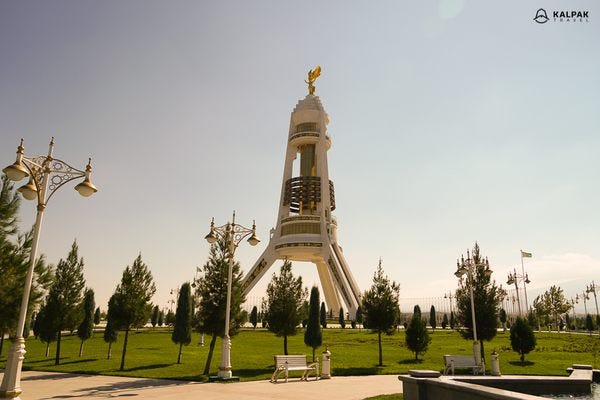

Other statues showed him sitting, striding, waving, saluting, and smiling a twenty-four-karat smile. One even showed him as a precocious golden child, seated in the lap of his bronze mother. He once said to a journalist,
“I admit it, there are too many portraits, pictures and monuments [of me]. I don’t find any pleasure in it, but the people demand it because of their mentality.”
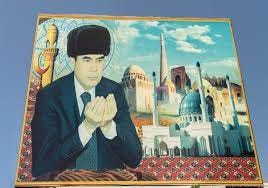
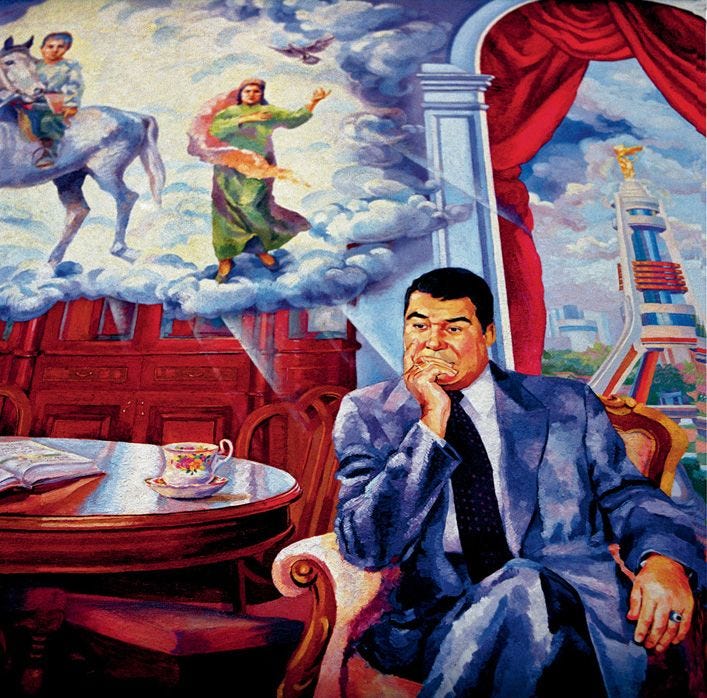
He plastered the entire country with hand-painted portraits of his book, his mother and himself, several of them measuring hundreds of square feet. In some, he looked like a fat grinning Dean Martin squinting in insincere friendliness. In others he was a he was a defiant leader with a chilly smile. A common image showed him, chin on hand, portrayed with a stack of books, like an author on a book tour. He gave every citizen a watch with his portrait in its dial. Not only did all Turkmen have his face on their wrists but in their wallets, after he put his face on every denomination of currency. He ordered every citizen to fly a Turkmenistan flag (redesigned with his face prominently featured), over their homes at all times, and wrote a new national anthem so that every sporting and political event started with a choir singing about how great he was.
He also built a vast space-age mosque, which he’d named after himself, Saparmurat Hajji Mosque, and he encouraged his people to visit it annually, in a kind of local hajj.
As with North Korean personality-cult hall-of-famers Kim Jong-il and Kim Il-sung, many decrees were based on Niyazov’s changeable whims. After heart surgery in 1997 forced him to quit smoking, Turkmenbashi forbade smoking in all public places. Then there was the Walk of Health. To encourage physical activity among the citizens of Ashgabat, Niyazov installed 28 miles of concrete paths and staircases in the parched, treeless Kopet Dag mountains. All government employees had to walk a 23-mile section of the path once per year. Niyazov was not shy about expressing his displeasure when their speed dipped below his preferred pace. He delivered these chastisements in person at the finish line, to which he traveled via helicopter.
Like most dictators, Niyazov looted the country's wealth. It is estimated that he siphoned off most of the country's estimated $2 billion a year in gas revenues and concealed them in offshore accounts. He also made sure that opposition was crushed. Any criticism or dissent was defined as treason and was punishable by long prison terms, confinement to psychiatric hospitals or internal banishment, mostly to arid salt flats by the Caspian Sea. Private conversations everywhere were monitored by eavesdropping informers, as well as by bugs and phone-taps and e-mails were monitored. Surveillance, already tight, was ratcheted up after a failed coup attempt in 2002.
That coup occurred when three gunmen opened fire on Niyazov's presidential limo. He was not injured but some of his guards were killed and wounded. Former Foreign Minister and current Chairman of the People's Democratic Movement of Turkmenistan (PDMT) Boris Shikhmuradov was arrested, tried, convicted of treason and sentenced to life in prison. Turkmenbashi, being the benevolent ruler he was, informed Shikhmuradov that he'd release him from prison on two condition – that he write two books: one about how he plotted the assassination attempt, and the other about how great Niyazov is and leave the country, never to return. Shikhmuradov wrote both books and left shortly thereafter.
A second minor civil disturbance during Niyazov's reign took place in the summer of 2004, when overnight a bunch of fliers were posted all over Ashgabat criticizing Niyazov and calling for his ouster. Niyazov gave his police force one week to find the traitors. When they failed, he fired his Cabinet, the Chief of Police, and the Director of the Police Academy on live national television.
The 2006 death of Niyazov may have dimmed his personality cult, but Niyazov’s successor, former Vice President and Minister of Health, Gurbanguly Berdimuhamedow developed a bizarre personality cult of his own. Berdimuhamedow’s fixation is Akhal-Teke horses, Turkmenistan’s national animal and emblem. The president’s equine predilections are something to behold. In 2011, Berdimuhamedow decreed that the nation would host an annual beauty contest for horses. His book, The Flight of Celestial Race Horses, opens with the words: “I won’t call you horse, I would call you brother, for you are dearer than the other.” He is now in a power-sharing agreement with his son, so it doesn’t look like Turkmenistan is going the way of democracy any time soon.
There you are the five strangest non-Roman leaders I could find. I hope you have enjoyed this journey into the depths of depravity, insanity, and ego. I’m not sure what I will have in store for you next time, but I’m sure it will be interesting. As always feel free to share this post with anyone who might be interested.
Chris
Since 1923, the city has hosted the 24 Hours of Le Mans, the world's oldest active endurance sports car race and one of the most attended and prestigious motor sports events in the world and on my bucket list.
Alp Arslan was the second leader of the Seljuk Empire. He fought a war with the Byzantine Empire and initiated Turkish migration into Asia Minor.

